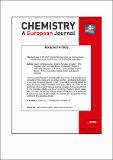Synthesis of ZIF-93/11 hybrid nanoparticles via post-synthetic modification of ZIF-93 and their use for H2/CO2 separation
Abstract
The present work shows the synthesis of nano‐sized hybrid zeolitic imidazolate frameworks (ZIFs) with the rho topology based on a mixture of the linkers benzimidazole (bIm) and 4‐methyl‐5‐imidazolecarboxaldehyde (4‐m‐5‐ica). The hybrid ZIF was obtained via post‐synthetic modification of ZIF‐93 in a bIm solution. The use of different solvents, MeOH and DMAc, and reaction times led to differences in the quantity of bIm incorporated to the framework, from 7.4 to 23% according to solid‐state NMR spectroscopy. XPS analysis showed that the mixture of linkers was also present at the surface of the particles. The inclusion of bIm to the ZIF‐93 nanoparticles improved the thermal stability of the framework and also increased the hydrophobicity according to water adsorption results. N2 and CO2 adsorption experiments revealed that the hybrid material has an intermediate adsorption capacity, between those of ZIF‐93 and ZIF‐11. Finally, ZIF‐93/11 hybrid materials were applied as fillers in polybenzimidazole (PBI) mixed matrix membranes (MMMs). These MMMs were used for H2/CO2 separation (at 180 ⁰C) reaching values of 207 Barrer of H2 and a H2/CO2 selectivity of 7.7 that clearly surpassed the Robeson upper bound (corrected for this temperature).
Citation
Sánchez-laínez , J , Zornoza , B , Orsi , A F , Łozińska , M M , Dawson , D M , Ashbrook , S E , Francis , S M , Wright , P A , Benoit , V , Llewellyn , P L , Téllez , C & Coronas , J 2018 , ' Synthesis of ZIF-93/11 hybrid nanoparticles via post-synthetic modification of ZIF-93 and their use for H 2 /CO 2 separation ' , Chemistry - A European Journal , vol. Early View . https://doi.org/10.1002/chem.201802124
Publication
Chemistry - A European Journal
Status
Peer reviewed
ISSN
0947-6539Type
Journal article
Description
The research leading to these results has received funding from the European Union Seventh Framework Programme (FP7/2007-2013) under grant agreement n° 608490, project M4CO2. In addition, financial support from the Spanish MINECO and FEDER (MAT2016-77290-R), the Aragón Government (T05) and the ESF is gratefully acknowledged. J. S.-L. thanks the Spanish Education Ministry Program FPU2014 for his PhD grant.Collections
Items in the St Andrews Research Repository are protected by copyright, with all rights reserved, unless otherwise indicated.

